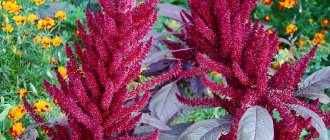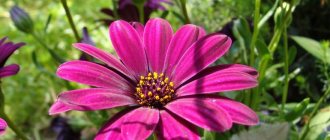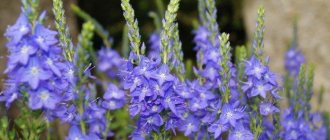Food
May 7, 2017
text: Tatyana Korsakova
Amaranth sprouts are very healthy - they are rich in antioxidants, omega-3 acids, minerals and proteins, but they are considered difficult to sprout. It's actually not difficult at all if you know a few tricks.
As they germinate, amaranth grains become like tiny pearls or air bubbles that rise up in a glass of San Pellegrino. They have a rich, juicy, nutty, peppery flavor that's the perfect addition to any meal, from sandwiches and yogurt muesli to salads and main courses. Not only is it tasty and healthy, it also looks very picturesque.
But there is one problem with amaranth: due to its tiny size, getting sprouts from it is not as easy and quick as, for example, in the case of wheat. It takes a little more time and skill. I became interested in germinating amaranth after talking with one of our country’s leading sprout specialists, PhD Natalya Shaskolskaya. She has been doing them for more than 20 years.
general information
Amaranth is a herbaceous annual of the same family, native to South America. Many thousands of years ago, the Indians considered it the flower of immortality and brewed a miraculous drink from it. Amaranth grains are popular all over the world even now.
Amaranth inflorescences are sometimes called cock's comb or fox's tail for their characteristic shape and color. They are equally good at any time of the year, fresh or dry. A large panicle is collected from soft dense spikelets of burgundy, purple or yellow color. It is almost impossible to visually isolate individual flowers.
Amaranth blooms in early summer and continues to bloom until frost. It has large matte green or burgundy leaves with raised veins. Amaranth is a tall and dense plant up to 1.5, and sometimes up to 3 m.
Photo: 2sotki.ru
Beneficial features
Various parts of amaranth have found their use in cooking, medicine and cosmetology.
- infusions are used to treat various diseases: the genitourinary system, constipation, hemorrhoids, colic. Also, help cope with inflammation on the skin;
- seed oil will help solve problems with the digestive tract (gastritis, ulcers, colitis, cirrhosis), and will also have a beneficial effect on the circulatory system (treats varicose veins, heart attack, hypertension, inflammatory diseases of the heart and blood vessels);
- young leaves have many useful elements and vitamins; they are eaten in salads, purees and soups;
- stems and leaves are used as an aromatic seasoning in various dishes;
- leaves and seeds are brewed as tea, added to compotes and fruit drinks;
- toasted seeds are used in baking and confectionery: sprinkled on buns, added to cakes and cream;
- crushed seeds are used to prepare porridge;
- Seed flour is added to doughs and sauces.
Important! Amaranth is contraindicated for people who have allergic reactions to this product. Most often it manifests itself in the form of nausea, dizziness and laryngeal swelling. In some cases, indigestion may occur.
Types of amaranth
There are many types of amaranth, and they are grown for completely different purposes. There are forage, vegetable and ornamental crops, and there are also ordinary wild weeds.
Vegetable amaranth
This species quickly and actively grows abundant foliage. It is edible along with shoots and grains. Vegetable amaranth is considered the most useful among its relatives.
Photo: kartoska.ru
Yellow amaranth
A compact decorative variety with a height of only 70 cm. One bush can have leaf blades of different shades of green, orange, yellow and bronze. The inflorescences are also yellow.
Photo: floweryvale.ru
Tricolor amaranth
This amazing species belongs to the decorative deciduous species. Each leaf is painted in several colors at once - green, yellow-orange and crimson. Its inflorescences are also large, bright yellow-red.
Photo: kartoska.ru
Tailed amaranth
A beautiful ornamental annual with large pendulous clusters that last until October. The varieties whose shoots are purple are very impressive.
Photo: 2sotki.ru
Dark amaranth
A tall, low-branching species up to 1.5 m tall with decorative erect inflorescences. Both the flowers and pointed leaves have a striking purple hue.
Photo: amaranth-ukr.com.ua
Upturned amaranth
This more compact and less branched species reaches an average height of 1 m. It has green inflorescences, a very powerful tap root, fleecy shoots and large ovoid leaves up to 14 cm in length.
Photo: 2sotki.ru
Paniculate amaranth
It is simply red, with red elongated inflorescences, which can be straight or drooping. It has very powerful, strong shoots up to 1.5 m tall.
Photo: zen.yandex.ru
Monarda (50 photos): types, planting and care in open ground
What do the seeds look like?
Many people do not know what amaranth seeds look like. In fact, it is not difficult to distinguish the grains of this crop from other plants. Amaranth planting material is very small. Light varieties of plants with green leaves have sand-colored seeds (like white sesame, only much smaller), with dense, smooth, slightly shiny shells. Such varieties are used for food and feed purposes. Plants with red leaves are ornamental varieties grown for their beautiful flowers. They have black seeds, also very small. Before planting amaranth seeds, it is recommended for convenience to mix the grains with sawdust, wood ash or sand in a ratio of 1:20.
The seeds ripen well when placed on inflorescences in a dark place.
The growing season of amaranth is 70 days, and the seeds are formed after 3 months of cultivation. The grains do not ripen at the same time, so it is easier to cut off entire amaranth inflorescences, otherwise some will simply end up on the ground.
When the panicles turn brown and dry well after about a month or two, you need to remove the seeds. They need to be dried only in a dark place.
You can simply clean them in the wind or on a very fine sieve. When stored in a dry place, amaranth seeds retain the ability to germinate for five years.
Amaranth care
The correct choice of soil is one of the main conditions for keeping amaranth. Otherwise, it causes no more problems than any other garden annual!
Temperature and lighting
Amaranth is very unpretentious and can withstand almost any temperature. As a southern resident, he was accustomed to the heat and scorching rays of the sun. But the culture adapts well to cold snaps down to 0 degrees.
Photo: vk.com
Watering
Mature amaranth does not need additional watering at normal times. Water it only when the soil dries out, if the rainless season has been prolonged. But young plants, especially during the rooting period, need to be watered frequently and abundantly.
Photo: domashniecvety.ru
The soil
The soil should be moderately moist and not acidic, because this promotes the development of root rot. Choose areas with loose and nutritious soil, and add a little lime before planting.
Photo: etsy.com
Fertilizers and fertilizing
Amaranth is fed approximately 3-4 times in the evening, when the heat subsides. You can use an ordinary mullein solution, which is even better than mineral mixtures. Nitrogen fertilizers are applied for the first time when the seedlings grow to 20 cm. But reduce the recommended concentration by half.
Photo: flo.discus-club.ru
Calendula (50 photos): types, planting and care in open ground
Growing at home
You can easily propagate amaranth at home using seeds collected at the end of the plant's growing season. The agarica produces plenty of seeds, so you don’t have to buy them. If amaranth is already growing at your dacha, collect the “harvest” from your own flowerbed. And if you are just planning to plant it, ask your neighbors: amaranth is a fairly common flower, so you don’t have to look for it like a fern flower.
Residents of the subtropics (for example, Crimeans living on the southern coast of the peninsula) can safely plant seeds for seedlings already in the last month of winter. But if you live in the middle zone and, accordingly, in a temperate climate, it is better to postpone the sowing date until March. Otherwise, you will have to spend a lot of time and effort on illuminating the seedlings. After all, at the end of winter, as a rule, there is still not as much sun as the plants need.
When choosing a container for sowing acorn seeds, give preference to wide containers, the maximum depth of which is 0.1 meters.
Preparing soil for amaranth
Having selected a container for sowing seeds, the container must be filled with substrate. In this case, you can do the following:
- Purchase a ready-made universal substrate for growing flowering crops at the garden center;
- Prepare the soil yourself by mixing the following “ingredients” in a 1:1:1 ratio:
- peat;
- humus;
- garden soil.
The basic requirements that soil for amaranth must meet are breathability, lightness, fluffiness and saturation with nutrients.
Before using prepared or purchased soil, be sure to disinfect it. For example, put it in the oven so that the earth is properly calcined. Or use more modern methods. For example, treat the soil with copper sulfate or colloidal sulfur.
We sow amaranth
As soon as the containers are filled with soil, take a spray bottle and generously spray the surface of the earth with water. But now you can safely proceed directly to sowing.
- Take the seeds and scatter them over the surface of the substrate.
- Lightly sprinkle the seeds with soil, literally half a centimeter.
- Cover the tops of the containers with cling film to create miniature greenhouses.
- Wait for the small plants to peck (if the house is warm, this will happen in about seven days), and as soon as you see sprouts, remove the film covering from the containers.
Immediately after one full-fledged leaf is formed on the seedlings, they will need to be picked. Each seedling has a separate peat pot. This is the only way to get healthy, strong and viable amaranth seedlings.
By the way, grain varieties of ashiritsa are distinguished by a high content of a substance called squalene. This is a hydrocarbon of natural origin, which, once in the human body, removes carcinogens from it and has an antibacterial effect.
Caring for amaranth seedlings
In fact, there is nothing complicated or unexpected in caring for amaranth seedlings. The main thing is to regularly water the picked seedlings and not allow the substrate in the peat cup to dry out. The soil should always be slightly moist. If you nevertheless decide to sow acorn seeds in February or the very beginning of March, be sure to provide additional light to the sprouts. No special equipment is required for this. Use a regular fluorescent desk lamp.
A week and a half before “moving” the seedlings to open soil - to a permanent place - be sure to start hardening the seedlings. This can be done in two ways. The first is daily ventilation of the room. The second is the daily, at least short-term, removal of cups with plants onto an unglazed balcony.
Replanting in open soil
As soon as spring comes to an end, feel free to plant seedlings grown with love. By this time, the seedlings will have become quite strong, and the earth will have warmed up well by the end of May. When choosing a location, give preference to a sun-drenched flower bed. Amaranth loves sunlight and grows and develops best in direct sunlight. You will find several recommendations regarding the process of transplanting amaranth seedlings into open ground below.
- The best method of planting is ordinary.
- The distance between rows is half a meter.
- The distance from one plant to another is 12-15 cm.
It is better to transplant on a cloudy day or in the evening, when the sun is no longer hot. For the first few days, it makes sense to organize something like a canopy for young amaranths to protect them from direct sunlight. Let the flowers adapt to new living conditions. In the shade this will happen much faster than under the scorching rays.
Amaranth, which grows in the shade, has a duller shade of foliage and inflorescences than amaranth, which is lucky enough to grow in the sun.
Caring for amaranth
For the first 60 days after the acorn seedlings are placed in an open flower bed, they will be extremely reluctant to grow. The fact is that during this period the flowers will form a root system. A flowering crop will begin to grow after the roots have completed their formation. Moreover, as soon as this happens, amaranth will grow right before our eyes.
- Weeding. During the first 60 days, you will have to weed the amaranth flowerbed at least two to three times. And perhaps even more. But as soon as the plant begins to actively develop, the need for active weed control will simply disappear - the giant acorn grass will crush the weeds with its authority.
- Watering. Soil moistening should be regular. It is important not to allow the soil in which amaranth grows to dry out completely, but at the same time to be 100% sure that moisture does not stagnate at the roots. Therefore, you must initially be sure of soil drainage.
- Feeding. Unfortunately, it will not be possible to obtain an enviable result without applying fertilizers. The following are solutions and products, the introduction of which into the soil will find the most effective response in amaranth:
- ash solution;
- nitrogen fertilizers.
Frequent use of nitrogen-rich fertilizers is unacceptable. Nitrogen stimulates the growth of green mass, but we do not need this. You should also remember that before adding any nutrients to the soil, the flowerbed must be thoroughly moistened.
Two months after transplanting into open ground, amaranth becomes 6 cm taller within 24 hours.
Planting and propagation
Amaranth can be planted with seeds directly into the ground, starting at the end of April. Planting of seedlings is carried out earlier - at the end of March, and the seedlings in this case are transplanted into the garden in the second half of May.
Seeds are planted in furrows to a depth of 1.5 cm one at a time, with a distance of about 45 cm between rows and 10 cm between seeds. It is better to spend time on sowing once than to deal with planting seedlings later. The taproot rhizome does not like transplantation and unnecessary disturbances. Shoots appear within 1-1.5 weeks.
Seedlings are planted in containers according to the same principle and left in a warm, bright place. For watering, use a sprayer and maintain the temperature at 20-22 degrees. In a week, expect shoots. When the first leaves appear, remove the weakest seedlings and plant the rest in peat pots.
Photo: steklotorgopt.ru
Description
If we talk about the description, it is worth noting that this plant belongs to the amaranth family. There are more than 60 genera and approximately nine hundred species. What does amaranth look like? Its height can reach 2-3 m, its thickness can vary from 8 to 10 cm, and its weight can range from 3 to 30 kg.
Amaranth leaves are large, wedge-shaped at the base and sharp towards the apex. Inflorescences can have different shapes and densities. All seeds are small and shiny and have different colors: from light to dark. This plant is quite unpretentious, resistant to disease and drought, but loves light and warmth. Due to the fact that the inflorescences have a beautiful fresh appearance all year round, this plant is often called the “winter friend”, which is consonant with the Greek translation: “amaranthos” - an unfading flower.
Diseases and pests of amaranth
Most often, amaranth suffers from root rot, which leads to the rotting of adult plants and the fall of seedlings. This can be avoided by choosing the right site, maintaining distance between bushes and controlling humidity.
Fungal diseases that affect shoots and leaves are treated with fungicides. In addition, there are varieties with increased immunity - we advise you to pay attention to them.
The most common enemy of amaranth is the weevil and its larvae. They not only eat leaves and stems, but also contribute to the development of fungal diseases. Colonies of aphids also periodically settle in dense bushes. Inspect your plantings regularly and use insecticides as needed.
Photo: flickr.com
Statica (50 photos): types, care and planting in open ground
Plant partners
Amaranth looks best near hedges and borders. Especially if they do not have aesthetic appeal. Shchiritsa is able to decorate with its appearance both concrete and poorly treated wood. And even the chain-link mesh next to such a “neighbor” no longer looks so depressing.
In fact, amaranth has no contraindications regarding partner plants: amaranth takes root well next to other flowering representatives of the garden. True, it is better to choose low-growing, shade-tolerant plants so that amaranth does not interfere with their development, or representatives of flowering flora that are similar in height to amaranth.
Amaranth is an excellent way to control carrot flies. It affects pests as a repeller. Therefore, it makes sense to plant acorn grass next to a bed of carrots in order to protect the root crop from annoying insects that spoil the crop.
Amaranth – photo
In our latitudes, amaranth is just gaining mass popularity, so, most likely, you have not seen it very often. In this case, be sure to take a look at our photo selection!
Photo: ecomne.ru
Photo: numerologyalexk.com
Photo: zen.yandex.ru
Photo: chudogryadka.mirtesen.ru
Photo: blog.leto-shop.ru
Photo: 2sotki.ru
Photo: serviceyards.com
Photo: artfile.ru
Photo: greeninhouse.ru
Photo: stiralkovich.ru
Photo: 2sotki.ru
Photo: gwallsbest.com
Photo: erpstat.ru
Photo: healthy-inform.ru
Photo: 2sotki.ru
Photo: plantorama.ru
Photo: dachadecor.ru
Photo: flo.discus-club.ru
Photo: na-dache.pro
Photo: 2sotki.ru Photo: fi.pinterest.com
Photo: bober-medcentr.ru
Photo: sovocrim.ru
Photo: evgenyart.livejournal.com
Photo: amaranth-health.com
Did you like the post? Subscribe to our channel in Yandex.Zen, it really helps us in our development!
Features of sowing
Sowing amaranth has its own characteristics, since this crop has very small seeds. It is more convenient to sow them in a common wide container with low sides. A drainage layer of fine expanded clay or perlite is laid at the bottom with a layer of 1.5-2 cm. Then the container is filled with prepared soil, leaving 2 cm to the top.
The soil is moistened with water from a sprayer, after which sowing begins. Due to the tiny size of the seeds, it is impossible to maintain a certain interval between them. It is more convenient to scatter the seeds over the surface of the soil, shaking them little by little from a white sheet of paper folded in half in the middle.
7 methods for checking seed germination that will help you not be left without seedlings
On top you need to sprinkle the crops with a layer of sifted earth 3 mm thick. When the work is finished, the crops are sprayed and covered with a transparent film. The shelter is used until seedlings appear on the surface.











